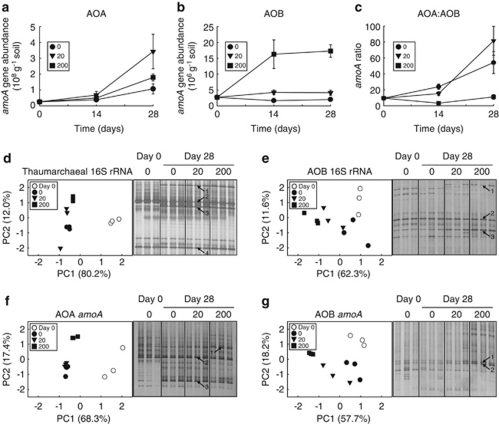Figure 2.
Characterisation of AOA and AOB communities in soil microcosms receiving ammonium amendments to maintain different target ammonium concentrations of 0, 20 and 200 μg NH4+-N per gram of soil. Changes in abundance were determined by qPCR analysis of the AOA (a) and AOB (b) amoA genes and (c) changes in AOA:AOB amoA abundance ratio, in soil microcosms destructively sampled after incubation for 0, 14 and 28 days. Each point and error bar represent the mean and standard error of triplicate microcosms, with some error bars being smaller than the symbol size. Changes in AOA (d, f) and AOB (e, g) community structure were determined by DGGE analysis of 16S rRNA and amoA genes derived from microcosms sampled after incubation for 0 and 28 days, with each lane representing an individual microcosm. Analysis of thaumarchaeal 16S rRNA gene sequences assumes that those organisms targeted by this assay also possess amoA genes and are putative AOA. PCR products derived from triplicate microcosms incubated for 28 days with either 20 or 200 μg NH4+-N per gram of soil were pooled and cloned with the sequences of predominant band positions (highlighted with numbered arrows) determined by screening and sequencing multiple clones with identical migration patterns before performing phylogenetic analysis (Supplementary Figures 2 and 3). Gel images were digitised and analysed by principal component analysis as described previously (Nicol et al., 2008).

